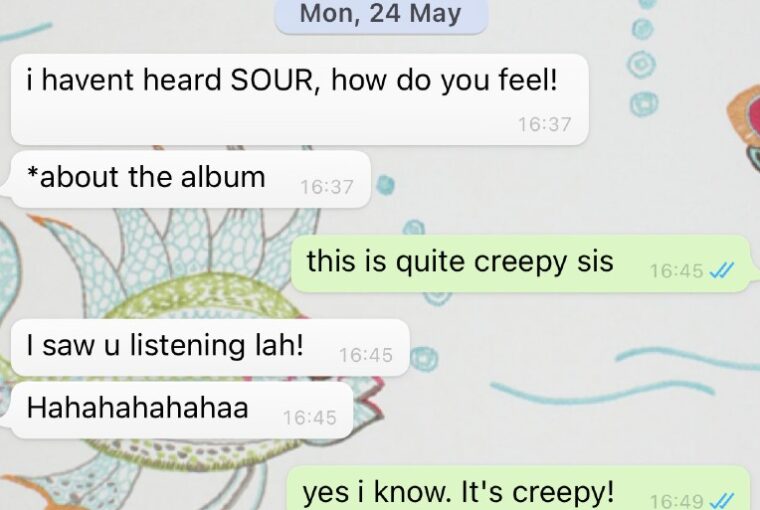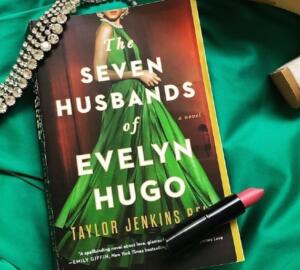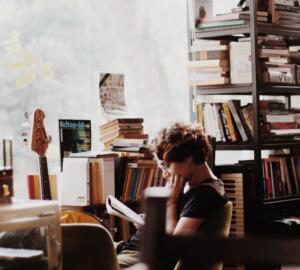A text message reminded me how Spotify Private Session was a life saver. It started when I was head bopping to Olivia Rodrigo’s good 4 u when I received a WhatsApp text from a friend in Hong Kong.
The message made me hit pause on the Spotify app and sit up straighter. For all the innocence of the text, she might as well have poured a bucket of ice-cold water down my back with the shock it induced in my system.
It didn’t matter that this came from a good friend. Or her valid question about Olivia Rodrigo’s debut album given our history of music discussions. I wasn’t ashamed that I was caught listening to Gen Z’s latest pop princess on Spotify that elicited such a response. Pop music is unabashedly right up my listening alley.
They’re watching
Despite consciously choosing to be mutuals on Spotify, I hadn’t expected my friend to actually be noticing. Well, not there at least. Unlike Instagram or Facebook, social media platforms where a post is an active act of engagement and intention, listening to music on Spotify is trivial – it’s background noise or a way to feed an earworm. And the Swedish streaming giants must think along the same lines given their incredibly unsophisticated privacy settings. However, with Spotify Private Session, everything changes.
To be reminded that someone is watching your private digital activity is akin to being caught with your pants down. Perhaps not the whole way to your feet. But definitely unbuttoned pants an inch or two from your waistband, with the tops of your underwear showing.
Does it matter though? Facebook has admitted to mining our personal data for advertisements. Omnichannel marketing and pixels allow our unchecked shopping cart to track us across our web surfing. Big tech is watching. Always, forevermore.

The curated profile
This is the paradoxical world of “rinstas” and “finstas” that now exists. “Rinstas”, standing for real Instagrams, is the highlight reel. Where sun-soaked vacation posts, sharp fashion fits, and bougie brunches with the besties are carefully curated. It’s where one might share snapshots of their professional work. An ironic name given how little of reality this account might reflect.
“Finstas”, ‘f’ connotating ‘fake’ or ‘fun’ and Instagram, is the photo dump. It’s a no-judgment zone with out-of-focus selfies, angst-filled captions, and a followers list more elite than the MET Gala guest list. Do not expect to find parents or any family here. This level of authenticity and candour is for very selected eyes only. One could almost speculate that the ‘Close Friends Only’ function that rolled out on Instagram Story in 2018 was made to address this need to compartmentalise.
Younger millennials and Gen Z grapple with developing their identity in very public spheres. Social media is the wild west where they can explore, express, form, and shape their sense of self. Can you blame them for trying to create a sense of order by multiplying accounts and dividing up niches?
TikTok’s biggest star Charli D’Amelio has 100 million followers on her main account. A typical comment here is some variation of a snide “why are you even famous?” trolling. Her second account, one that doesn’t even have a unique username, has a mere fraction of the number with 10 million followers. Posts are goofier and comments are less mean-spirited, despite the fact that she has never officially acknowledged its existence. Given the positivity elicited in a finsta account, it’s no wonder one would want to find an escape from the toxic pressure of the rinsta.
Public or Private?
For what it’s worth, Olivia Rodrigo’s SOUR is a bop. As I would share with my friend, this review in The Cut accurately captures anyone above the age of 30 listening to the album. But I wished that my opinion had been freely solicited rather than imposed.
In a world that has gotten incredibly public and integrated, the harder we cling to what little vestiges of privacy we can hack together. However, there’s no proof it will amount to any difference in the long run given the existing damage of systems. But while we can, we’re going to try our damndest to control our narrative.
How to Turn on the Spotify Private Session?
Turning on the private session is easy-peasy, both in the desktop and mobile app settings. So, in just a few seconds you can be listening to your guilty pleasure music without feeling guilty at all!
Private Session in the Spotify Desktop App
To turn on the private session in the Spotify desktop app settings (on Windows, Mac, or Linux), follow these simple steps:
- Open the Spotify app on your computer and click your name in the right upper corner.
- When the menu opens, choose “Private session”.
- When you do it, you should see a padlock icon next to your name – it means you have successfully launched the Spotify private session.
Private Session in the Spotify Mobile App
If you want to start a private session in Spotify on your iPhone, iPad or Android device, change the settings in the following way:
- Open the Spotify app on your mobile device and tap the “Home” button at the bottom left.
- When the “Home” screen opens in Spotify, click on the “Settings” button in the top-right corner (a gear icon).
- Scroll down to the “Social” section. You will see a “Private session” option – toggle it on. And now you’re free from Spotify stalkers!
As you can see, you’re just a few clicks away from listening to whatever you want on Spotify without thinking about what your friends will say. The Spotify private session saves the day!








